#mosaic ring
Text
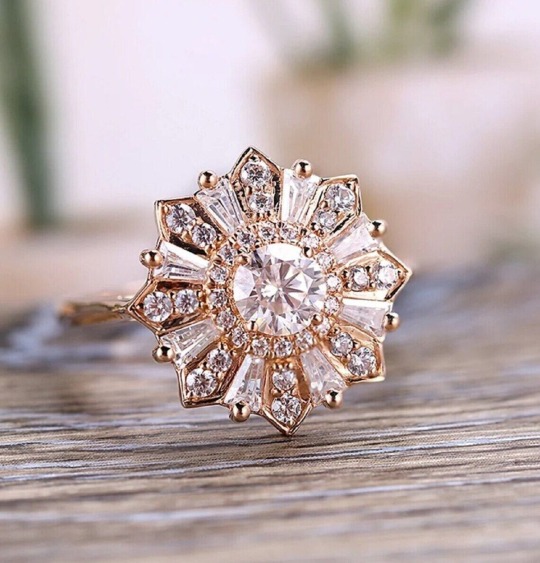
#missradiantjewels#engagement ring#moissanite#diamond ring#wedding ring#moissanite ring#handmade#round cut ring#mosaic ring#mosaic engagement ring#art deco ring#round halo ring#round moissanite ring#flower ring#etsyshop#etsyfinds#etsyseller#etsy shop#Ballerina Ring#Starburst Ring#Tapered Baguette#Baguette#Baguette mosisanite
0 notes
Text




Capitello Ring by Le Sibille
32 notes
·
View notes
Text
Dragon Age Iconic Patterns: The Sun

In this post I will try to extensively gather all the sun-based or sun-like imagery that we find in all the games of Dragon Age. From the most typical ones to those which may seem obscure or with a hidden allegory/design. I will qualify their resemblance with the Sun symbol as Strong, Weak or other.
This post contains the following symbols
Chantry Sunburst
Elvhenan Culture: Sun symbol among the Evanuris
Elvhenan Culture: Asterisk Symbol and Elvhenan Doors
Elvhenan Culture: Golden Ring
Elvhenan Culture: Crappy Sun
Elvhenan Culture: Elgar’nan and Sylaise
Elvhenan Culture: Murals
Tevinter Culture: Green Star
Tevinter Culture: different decorative elements
Dwarven Culture: Fairel and Dwarven art
Ferelden Culture: The Sun Face and the geometrical Sun
Grey Wardens and the Sun
Avvar and the Sun
Flemeth
Qunari, Par Vollen, and the Solium Constellation
DAO design
Free Marches Rural Areas
[This post belongs to the series “Analysis and speculation of Statues”]
[Strong] Chantry Sunburst
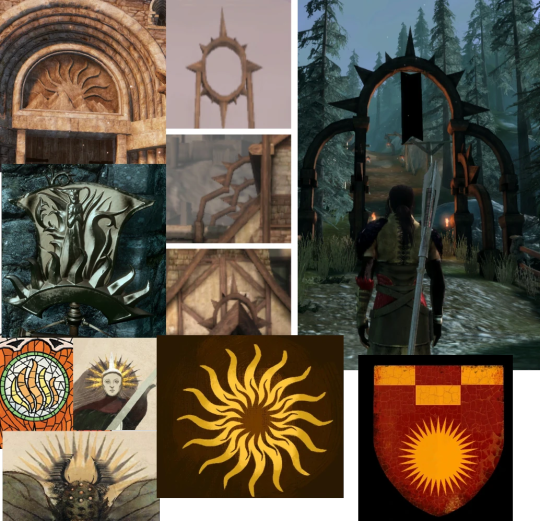
The most typical one that appears in DA series is the Sun or Sunburst with wavy rays, repeated so much along the games that we can identify it immediately. It’s the unequivocally symbol of the Chantry. We found it in many versions, and it represents the “dawn” with the idea of hope and “new beginnings”, but also the fire that “purified” Andraste in her pyre to let her ascend to the Maker’s side. In the posts of Andrastian Art [Andrastian Design: Stained Glasses], we also find that “balls of fire” [which can be interpreted as a Sun in another way] are shown to represent the Maker or the Faith in Him.
Andraste’s single spiked helm seems to be inspired in a single sun ray, at least this is what an illustration in the Chant of Light [book of World Of Thedas] seems to suggest.
In general, most of the representations of the Chantry Sun have 16 rays.
The same sun-like symbol appears in its Tevinter version when we see the Imperial Chantry; the only difference with the Orlesian one is that the Tevinter Sunburst has straight rays.
As a detail, in DAO, we had the typical representation of the wavy sunburst present in some strange devices of Tevinter origin, for example, the ones we found in [Brecilian ruins], while the main Church in Denerim, or in Haven, display spikes that, more than resembling a sun, look like thorns or even a thorny vine. This may be a consequence of an original plan in linking, design-wise, the chantry symbology with the thorny vines that represent the Blight or the Darkspawn [As we explained in the section “Non-mural symbol: Thorny vines” from Murals in DAI: Basics], or merely it was a limitation of the design of the game, as we know DAO suffers from.
We also know that tranquils should display this symbol on their foreheads, burnt with lyrium, but as we saw along DAO, none of them had it. Later we were informed that the devs had problems to add this mark on the npc, therefore, it was never shown until DA2. When it comes to this symbol, it is interesting to see that tranquils carry the metaphor of “a Sun burning their minds and emptying them”, which may or may not be related with Dwarves and their fear to the Sun and potential relatinship of Elgar'nar shoving a fire ball into their underground lands [More details of this concept in Deep Roads [DLC Trespasser]: Lower Walkways in particular with the codex Torn Notebook in the Deep Roads,].
[Strong] Elvhenan Culture: Sun symbol among the Evanuris

Strangely close to the Chantry Sunburst symbol, we find the “half” sun symbol [tagged along the blog as Sun-head creature] in what we suspect was one of the ancient primordial dragon symbols that some Evanuris took over when they claimed Divinity [for more context, read Attempt to rebuild Ancient Elvhenan History]. It’s hard to say which Evanuris took control of this symbol, but we know there is a clearly sun-like symbol present in the Crossroads of the DLC [as a statue, check The Crossroads [DLC Trespasser]: Entrance] and in the Shattered Library [as an Eluvian, check Shattered Library; Entrance and Courtyard]. With the release of the Vinyl, we also discovered and reinforced the hypothesis that this symbol belongs to or was co-opted by an Evanuris [read Speculations about the Vinyl Art for details] thanks to the image of an elf wearing a hat with that shape.
A consistent detail of this image is that it’s a half-sun with exactly 7 rays.
[Weak] Elvhenan Culture: Asterisk Symbol and Elvhenan Doors

If we extend this imagery, and check other symbols that may look similar to a sun, we find the ancient Elvhenan Doors [Elven Ancient Shard-based door], which top displays a pointy sun of 8 rays that may or may not be related to the Asterisk symbols [also related to the Titan’s core, which I talked about in the post of Murals “The Death of a Titan”]. In the way the door gets illuminated when activated also makes us see a “circle” in it that can be loosely related to the “Golden Ring shape”. More details about this ring will be treated below.
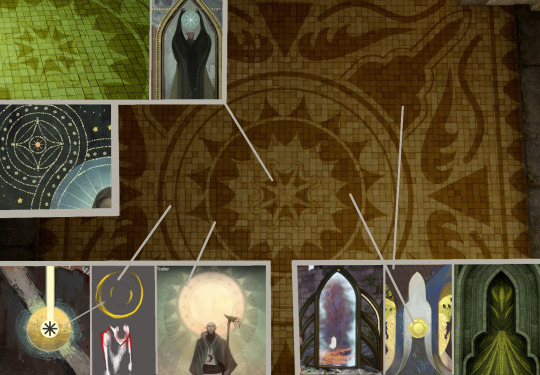
This strange sun on the ancient door also makes us think in the Asterisk Symbol [made of 8 points], which lays at the centre of the yellow mosaic, which may be related to the core of a Titan [asterisk of 8 points too]. The link is immediate when we see that this asterisk is outlined by a shape that looks like a star or a Sun, inside a big ball with triangular-shape ends. This same symbol appears in the last Trailer of DA4, behind Solas, when he is presented like an Hermit, mysterious, apostate mage. Around this “sun” we can make out several concentric lines that may refer to a “Golden Ring”.
The Asterik symbol also appears in murals such as “The Creation of the Veil” or “The Death of a Titan”, which allowed us to relate them with the core of a Titan and its immense power of "making real what you imagine"reinforcing the reality", but this symbol also appears in a corner of Solas’ tarot card.
The yellow mosaic also has some shapes at the four corners that may represent eluvians or something related to Mythal. In the mural of “the Temple of Mythal” from “The actions of the Inquisitor”, we see that Solas draw a particular star of 8 points inside a door frame that resembles this “eluvian outline”, but it’s also the shape of the doors of the Temple of Mythal which represents Mythal herself in her dragon shape. All these symbols seem to reinforce the idea we explored in “The Death of a Titan”: Mythal seems to be related to the core power of a Titan represented by an asterisk that evolves into a golden ring and into a sun.
As I repeated several times in Speculations about the Vinyl Art, at times, we find some hints where stars or balls of fires [also understood as suns] are related to Mythal and Elgar’nan, making us suspect that, maybe, Mythal and Elgar’nan share a nature similar to Falon’Din and Dirthamen’s: apparently, the same creature with two different aspects from them. If this were the case, associating Mythal with the Sun would make sense, and it would also explain why, if Elgar’nan was so central in the Elvhenan culture, there are so few representations and statues of him, while Mythal overwhelms it.
[Weak] Elvhenan Culture: Golden Ring

During the last trailer of DA4, we see Solas turns into the Black Dread Wolf as a sun in the background becomes a moon [single golden circle] and later, it separates itself into concentric rings, that may or may not be related to the “Golden Ring” so deeply entangled with Elvhenan culture. Thanks to this imagery, we may relate the Sun to the Golden Ring [specially if we consider that the mural presented in Nation Art: Elvhen displays the yellow ring in a position that may be considered “the sun”, but also the "authority/power above"]
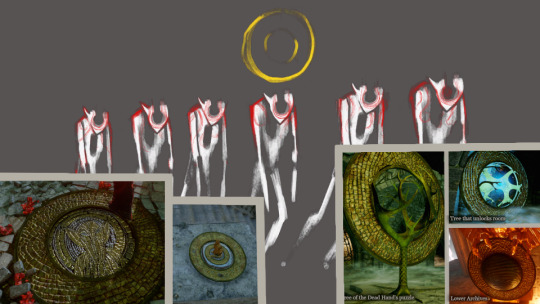

We need to remember that the Golden Ring’s presence is always associated with control, power, and occasionally to Mythal and Dirthamen. In the mural of the “zombie elves”, it’s above all of them, and due to this position, it could be interpreted like a “sun” or moon upon the controlled, zombified elves. But I’m not too convinced in this interpretation, since we already explored in posts such as: Nation Art: Elvhen, Exalted Plains: Ghilan’nain’s Grove and the Dead Hand, DLC: Jaws of Hakkon - Frostback Basin, Elvhen Tomb, Ancient Elven codices; Fen’Harel’s mountain ruins, The Crossroads [DLC Trespasser]: Elven Mountain Ruins; Vine-covered Tower, Murals in DAI: The Death of a Titan, and Speculations about the Vinyl Art that this ring was more related to control, power, or even forced change/shape in some cases. Due to its power or potential knowledge, it's also associated to Dirthamen Owl [which also could be Andruil's owl according some inconsistencies in the same Unreliable Dalish legends].
On the other hand, it’s never clear if this symbol may have morphed into a sun along the ages with the loss of memory that the Elves had throughout generations when they lost their immortality. However, I tend to consider that this Golden Ring may have changed into a Sun when it entered in contact with human groups, in the same way that I see the story of Fen'Harel gave enough context for humans to create the Maker myth based on him, potentially during the time of Halamshiral [for more details, read The Chantry and the Mythology of the Chant of Light]
This ring also appears in the last scene of DAI, when we defeat Corypheus, showing Mythal inside it, as bits of red lyrium sprout around it. This can be related to many speculations done in Speculations about the Vinyl Art, where we can conclude that another fragment/part of Mythal is still trapped in the Black City, corrupted, and contained by an immense power that may have been used before by the rest of the evanuris to control their own people.
The Golden Ring has also been seen enclosing Elven Tree Statues and Elven Orbs, implying its relationship with elvhenan power and/or Mythal’s [after all, we know that Mythal took the power from a Titan from which elvhen orbs were developed, and trees are also her symbol, according her vallaslin]. It's worth noting that the only working orb we saw in the game was Mythal’s, so far.
[Weak] Elvhenan Culture: Crappy Sun
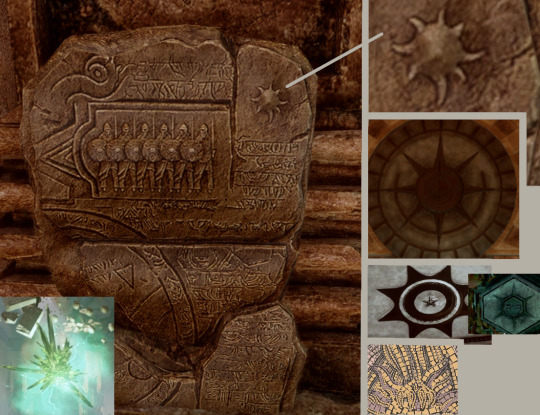
There is also a strange symbol that I called “crappy sun” in the ancient tablet we find at the entrance and deep into the tomb of Forbidden Oasis: Solasan Temple [along this blog I’ve tagged it as “Stone in Razikale-Ceremony-style”]. It’s hard to say if it represents a sun or a breach. It may be related to a sun similar to the one of the Elven Ancient Shard-based door that, later, Tevinter co-opted to turn into the several versions of pointy suns we see in Tevinter Pre-blight ruins, [let’s remember they were not Andrastian yet, and still they had this symbology in their buildings and elements because it may have been related to ancient dragons, or taken from another elvhen symbology during the time of the Dreamers since there are some proofs, such as the Tevinter Mosaic [Invasion], that may show that Tevinter had a better relationship with elves back then].
Maybe the original symbol was related to Elgar’nan, as we see in his mosaic, where he shoves down the sun into the earth, and its rays are wavy and a bit “crappy”. If this relationship is correct, maybe what Elgar'nan shoved into the Earth to destroy the dwarves/Titans was not a sun but a breach? Again, a very unlikely hypothesis.
This “crappy sun” also has 8 rays.
[Strong] Elvhenan Culture: Elgar’nan and Sylaise
Elgar’nan’s mosaic was interpreted in the post Evanuris, and basically shows an elf shoving down a Sun of wavy rays into the Earth. It’s easy for us to relate this image to the unreliable Dalish legend of Elgar’nan [read Elgar'nan: God of Vengeance]. Elgar’nan is presented here as the son of the Sun itself, who tried to burn all life on the Land out of Jealousy, so Elgar’nan vowed vengeance against his Father’s cruelty, and his rage won against the fire of the Sun. Then, “Elgar'nan threw the sun down from the sky and buried him in a deep abyss created by the land's sorrow.”
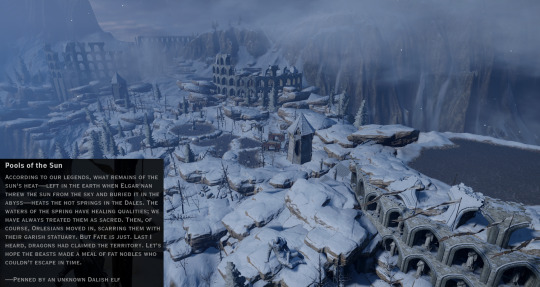
This story can be followed later in the post Emprise du Lion: Pools of the Sun, where we find another unreliable Dalish legend claiming that this place has spring waters because it was here where Elgar’nan shoved the sun into the Earth. I also made a link to Sylaise considering the Elvhenan arenas we can see in this region, the presence of Sylaise’s Shrine, and her thirst for being always competing with someone. These details can make us suspect that this Sun could have been Sylaise [so deeply related to fire, the sun, and also as angry as Elgar’nan according the Song to Sylaise].
It’s very worth noting that these two legends, said by different clans, claim that Elgar’nan pushed the Sun into the Abyss. Another detail we have to assume is that "Abyss", "Beyond the Deep Roads" and "The Void" seem to be one thing related to the places where the Titan sleep [or even inside the Titan themselves] instead of a strange dimensional pocket we never saw before. This links the Elvhenan with the Dwarven in what we speculated in Murals in DAI: The Death of a Titan.
With this relationship, we see again the Sun as a weapon of destruction and control.
[Weak] Elvhenan Culture: Murals

Murals present a red sphere with rays that may imply a Sun .
In the mural “The Creation of the Veil” [1], we find a red sphere inside a black one, making us suspect it’s the big evil released by the Evanuris that Solas isolated with the creation of the Veil. Around it, there are seven “bubbles” with similar “rays” in grey and golden colours that may imply “gates” that would allow us the access to the central “sun” or red sphere.
In the mural “The Death of a Titan” [2] we talked extensively about the asterisk symbol, its representation of a Titan’s heart and all that power associated with it, as well as with Golden Rings. The codex in here speaks of a red sphere that contains fury, and maybe all of this can be related to a sun, or better said, the other way around: a Sun as a sphere of fire, related to fury, and buried below underground to contain its destruction. This also brings us some similarities with the unreliable Dalish legends about Elgar'nan.
In the mural “Red Lyrium Idol” [3] we also commented how the image looks as if Solas were walking on a sphere of fire. It may be related to the red lyrium idol too. Here, we keep linking this idea of a “sphere of fire” as a potential Sun.
In the murals of “The actions of the Inquisitor” [4], we see several times that the red sphere associated with the big evil isolated behind the thick, impenetrable barrier of the Black City seems to be positioned in places that may allow a soft interpretation as a “sun”in the sky.
These symbols seem to gather more importance as we analysed the Vinyl Art, where we find the concept of the Eclipse [as an ominous symbol of Fen’Harel that covers and hides the Sun] and a lot of iconography of stars, which can be interpreted as “suns”.
[Weak] Tevinter Culture: Green Star

Pre-Blight Tevinter art has a “star” symbol that may be interpreted as a sun, specially if we consider that the inside of this green star displays the symbol of the elvhenan Golden Ring in red colour. However, it seems more likely to be a symbol representing the power that one can extract from the Breaches. The green colour helps in this interpretation and puts it a bit farther away from a sun interpretation than other symbols. However, it keeps linking the Golden Ring with the power of creating a Breach.
[Confusing] Tevinter Culture: different decorative elements
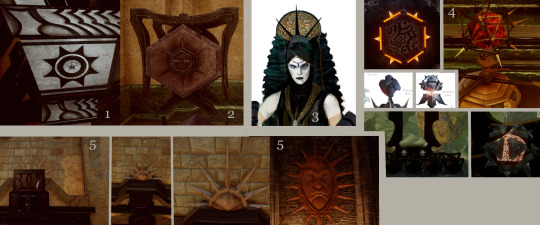
The rest of the symbols in Tevinter objects may have some relationship with the Sun. For example, we find doors, boxes, and columns decorated with an 8-pointed star [1] but we also find another one with 6 points in something that looks like a box [2]. The shape of an “hexagonal” sun of 8-pointy rays can be found as well in objects like the “scrying orb” [4].
Among the outfits, we find a 3-ray comb used by Tevinter women [3], which may be related to the sun-based symbol of an Old God [and potentially related to the corresponding Evanuris associated with it]. This symbol is a lot closer to the "Sun-head creature" we found among Elvhenan objects.
As a curious one, I will always point out the strange, hidden Sun figure that belongs to the Free Marches decoration that can be found at the entrance of the Inner Sanctum in Western Approach: The Still Ruins, Viridis Walk and Inner Sanctum.
I think it’s clear and safe to say that most of the sun-based symbols present in Tevinter culture [and previous to their conversion to Andrastian religion] may have been originated from the contact with the Elvhenan [during the Dreamer time where we can see less repulsion to Elvhen according the Tevinter Mosaics] or [most likely] with the dragons that may have been related to the Elvhenan, as I made the connection in the comic post The Missing.
[Weak] Dwarven Culture: Fairel and Dwarven art

The Dwarves, at least the ones in the Fairel’s ruins, may have some link with the Sun as well. In these ruins we find the same exact stone tablet we find in the Ancient Elvhenan tombs [1], which displays the “crappy sun” I commented above. Once again, it could be a sun but also a breach, so there is no much sense to keep focusing on it.
Another symbol to relate the Sun to the Dwarves may or may not be an old “Dwarven stone-paintings” we saw since DAO, which basically shows a dwarf working the stone [3]. Based on symmetry, we could assume that the triangles on the background are stalagmites, but if we stretch-out this interpretation, they could even be seen as a sun with its rays. It’s very unlikely, since it seems to be more a design resource to highlight the scene of the stone-painting, but for completion’s sake I think it’s worthy to keep it commented here.
However, this simple design allows us to interpret it in different ways: the spikes we see can be pieces of rock protruding from the ground and the Dwarf in it is mining them [as its original codex in DAO seems to imply], but also it could be understood as a quarter of a Sun peeking through the corner of the image as a Dwarf works tirelessly.
Later in DAI we are introduced to another piece of art of similar characteristics [2]. The building was never possible to be identified unequivocally, and in posts like “Architecture of Kirkwall : Gallows and Lowtown/Darktown” I related it to representations of Kirkwall or cities that may be similar to Kirkwall where the runecraft mastery of dwarves was used [and probably, it was a source of pride for these clans, who may have kept the achievement immortalised in a piece of art reproduced among the noble dwarven families]. This piece also shows a background very similar to the one in [3] that may be a representation of stalagmites or a sun, if it’s stretched-out enough.
Another strange symbol in the dwarven furniture is the one presented in some stone-seats: an elaborated metal image that shows thorny vines on or over a sun [4]. This symbol appears in many other parts of the game where there are dwarven rooms, but also in Arbor Wilds :Cradle of Sulevin where we can read the Vir Tanadhal, However, in this case, the symbol is not completely the same one than in the Hissing Wastes: Fairel tomb.
It’s hard to suspect if this is a mere reuse of assets, it has a lore-related meaning, or it’s just a reflection that the Dwarves and the Ancient Elvhen had a relationship quite ancient [as it shows the Elvhen tree and its dwarven, more geometrical style, that I’ve been pointing out since DAO in Orzammar]. We have to remember that the Ancient Elvhenan saw the dwarves as soulless creatures, workers of the “pillars of Earth” and worthless. However, I always claimed it was never clear if this was a reference to ancient Dwarves that were linked to the Titan deeply to the point that they became Sha-Brytol after the break of the link, or were related to more independent dwarves as the ones we see now, who have a sense of Stone, but can’t understand the Titan with the exception of some gifted ones [such as Valta].
Finally, the dwarves have an additional aspect related to the Sun in the very unreliable codex called Torn Notebook in the Deep Roads, Section 2. I wrote about this codex in a more integral way in Deep Roads [DLC Trespasser]: Lower Walkways. But basically an ex-Dalish elf [now a Qun converted] relates Elgar’nan’s fire [which another unreliable Dalish legend, Elgar'nan: God of Vengeance, claims he shoved the Sun into the Earth] to the fear to the Sun that Dwarves experience [Read the section Elgar’nan and Sylaise above]. This may have been a Dev’s choice to makes us aware that there exists a relationship between the Sun and the dwarves, even though there is no lore material that can make it clear enough.
[Strong] Ferelden Culture: The Sun Face and the geometrical Sun

In the Tryptich presented in Andrastian Design: Tapestry and Tryptich, we find three symbols on top of each part of the scene: the six-snakes that represent Tevinter, the golden city above all the image representing the Maker or the Chantry Religion, and over the section of Ferelden/Orlais chantry, a 8-pointed sun which rays look like triangles. Once again, the resemblance of this symbol with the elvhenan sun in the mural “Temple of Mythal” is remarkable [check the Temple of Mythal in “The actions of the Inquisitor”] or the sun shape in the elvhenan yellow mosaic or in the background of Solas in the Trailer of DA:D. This could come from different roots:
1- An Orlesian root, considering how much of the elvhenan influence it had during the time of the Halamshiral and the coexistence of humans and elves in the Dales for some years [to the point where inter-racial families were made, as it was hinted all over the Exalted Plains]. I spoeculated how the idea of the Maker may have been developed during this time in the post The Chantry and the Mythology of the Chant of Light
2- Another potential root is related to the Alamarri root, and therefore, linked to the Avvar: this sun may be a representation of the Lady of the Sky for the same reasons I will explain below in the Section Avvars and the Sun.
We can find similar icon in the book World of Thedas, where they show a unique Ferelden Tryptich [3], which top displays this symbol with a sun that even may have a shape of a Golden Ring within it. In either case, we know that this symbol later was part of the Ferelden Chantry, which sun is very pointy, as DAO showed it [see the first section in this post: Chantry Sunburst].
In DAI, we find in some small towns of Ferelden, a unique strange Sun with a crying face [1]. On it we see a bird and a squirrel. It’s hard to know exactly what this is, [check the post Nation Art: Ferelden], but maybe it can be understood as a representation of Andraste made by Ferelden culture mixed with some local animals and fables created as a mixture of cultures, similar to the tale that related Wyverns to Andraste [check the wyvern section in Dragon Age Iconic Patterns: The single spike].
There is also a fish drawn in the DLC of Hakkon on a fisherman shack [2], which displays a pattern that can be related to the “crappy sun” designs on its skin. Not sure what to make about it. The closest is that the Avvar represented this symbol as a way to reflect what they may have seen in the Isle of the Lady, where a big ancient breach have been there, open, since the time of Telana [read about this in “The Veil and the preservation of the Waking World” from the post Frostback Basin [DLC]: Miscellaneous ].
[Strong] Grey Wardens and the Sun

The typical symbol of the Grey Wardens involves a chalice that represents the Joining ritual. It always displays a Sun, and not any sun: it’s one with a strong resemblance to the Sunburst of the Chantry. Let’s remember that the Grey Wardens was and is an independent Order that doesn’t respond to the Chantry, and even more so: it was created before the existence of the Chantry, and before Andraste was born. So any quick explanation that this sun is present in this object due to some potential influence from the Chantry seem unlikely.
However, as I showed in Western Approach: The Still Ruins, Main Chamber and Hall of Silence, there are griffons with this same chalice that belonged to pre-Blight Tevinter, maybe remotely associated with Dumat in some ways [since they appear in a hall called “Hall of Silence”, and Dumat=Silence]. We know that the Joining, as a ritual of blood magic, came from the knowledge of Arlathan elves and Tevinter Mages during the desperate times of the First Blight when nothing seemed to stop the darkspawn and even slaying Dumat did not work the first time. Therefore, this Sun may have some relationship with the elvhenan, the Old Gods, or just the blood magic that allowed the creation of the Joining.
[Curious] Avvar and the Sun

The Avvar have a symbol that I always found very Sun-like due to its design and cultural concept: The Lady of the Sky. It’s not only the concept; the lady of the sky can be any important object in the sky; moons or suns. Since Thedas has two moons, it seems more plausible to think of her as unique as the Sun itself.
In the painting that represents her (found on a wall in the Frostback Mountains) we see a design of an owl which shape looks like a Sun. Even her sculpture in Skyhold displays small spikes around her neck which give her a low-key “sun-like” design, specially if we relate this shape with the “sun” shape we saw in the Ancient Elvhenan Yellow Mosaic or with the star we saw in the “Temple of Mythal” mural [in “The actions of the Inquisitor”] or with the Sun that appears behind Solas in the trailer.
Curiously, her banner displays her eyes in a shape that looks similar to the Golden Ring shape, but in black colour. That the Avvar have an art that may have resemblance with Elvhenan's is not strange for me if we remember that Tyrdda Bright-Axe Path’s story narrates that her lover was an elf that, as it is hinted, may have been the Lady of the Sky herself. This means that the Avvar always were a culture under the influence of the Elvhenan and the Dwarves [due to the marriages they arranged with the children of the Stone].
[Weak] Flemeth
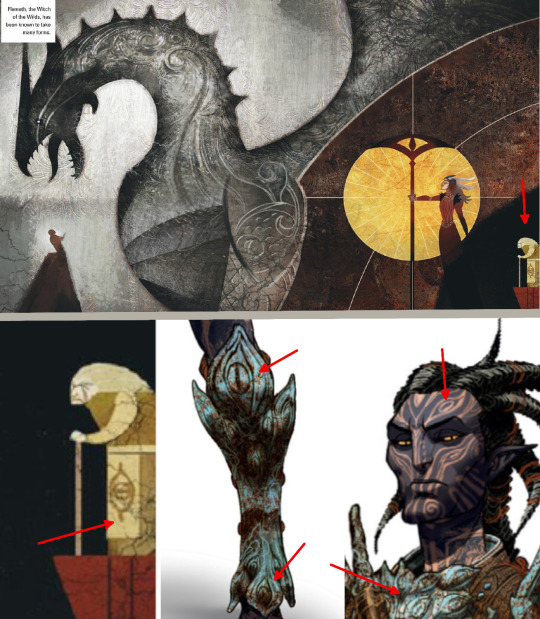
Flemeth also had a unique concept art that shows all of her nature in one drawing: her dragon shape, Mythal, as the central part of it over a human figure that may be a petitioner; a bit aside and as if she were in a inner ring of a brown sphere, The Witch of the Wild: Flemeth, with a very particular staff inside a yellow circle that may be interpreted as a Sun. And very hidden in the corner, in the core of this sphere, now black, we see her as an "old, old woman" with a big eye drawn on her apron, at the edge of a cliff [potentially representing the fragment of Mythal that lives inside her]. This kind of eye is very similar to the ones that we see in the concept art armours of Mythal’s temple guardians. I assume it has to do with her omnipresence due to the manipulation of dreams [we know that she presented herself in dreams to an elf and marked him with the Vallaslin of Mythal after awakening, check the video]
Mythal also has bland hints related to Elgar’nan symbology, which is related to the sun, fire, and balls of fire with anger [check all this in the posts Speculations about the Vinyl Art and “The Death of a Titan”]. Flemeth ends up being related to all this since she carries a fragment of Mythal in her.
[Strong] Qunari, Par Vollen, and the Solium Constellation

The Qunari have little link with the Sun, but not the land they conquered. In the book World of Thedas we are informed about the existence of the Fex, a race we never saw nor had much information beyond the fact that they exist. May they be related to the Sun or a Sun-base proto religion? We don't know.
In the Codex Constellation: Solium, we learn that this constellation [which looks like a Sun/Star, image above, pretty similar to the Chantry Sunburst I may add] may have been a representation of the Sun or the Moon [or both] for the Neomerian [Ancient Tevinters], however, it could also represent Elgar’nan, since unreliable Dalish legends claim him to be the “eldest of the Sun”.
Another Codex, called The Pyramids of Par Vollen, tells us that the Jungles of this continent have ancient ruins that doesn’t seem to be tombs but places of scientific purposes. The shape of these ruins fits perfectly with the constellation of Solium, making them, in some way or another, related to the Sun. These pyramids are a great mystery in the DA lore, especially for their total lack of information beyond this codex. We know their walls show images of “intricate sea creatures, shipwrights, musicians, archers, and kings. Odd figures are depicted, tall, horned, always in a position of authority and respect.” It seems that there was no resistance when the Qunari came to conquer this place, so we can suspect that this previous civilization embraced the Qun without much resistance, in part, because the Qunari have horns, and that caused respect and authority. Or the civilisation had been gone long ago when they came. Or it was a civilisation that was developed by or under the authority of the Kossith, the ancient Qunari who had no Qun.
The brief description of these ruins also makes me link it, potentially, with the underground ruins we find in The Horror of Hormak .
[Confusing] DAO design
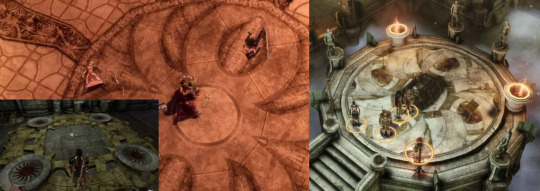
This section tries to relate the Sun shape with designs that may make the connection a bit stretched or not truly reasonable, therefore, DAO leads this part, lol.
We find that many places along the game, specially the ones related to puzzles [Honnleath and Enchanter Wilhelm’s basement] or to Tevinter experiments [Ruins of Brecilian Forest] display a platform on the ground with a symbol similar to the Sunburst of the Chantry. I’m not sure why they are there, specially in the Brecilian Forest, since we know this was a fortress probably developed by Tevinter [ which potentially may have co-opted, as usual, an ancient Elvhenan building and claimed it as its own] just to be taken by Dalish and humans later. This Fortress is a mess in terms of design and statues that it displays, so it’s hard, if not impossible, to truly take it seriously. To me it all feels more like a reuse of graphical resources, but just for the sake of completion, I add the present section.
More of these sun-like platforms can be found in the Tower of the Circle of Magi [which could potentially make sense since the tower was made by Avvar and Dwarves, and it may be a representation of the Lady of the Sky, as we saw in the Avvar section of this post] but also in the Temple of Andraste or in Denerim at the Fort Drakon which makes less sense [unless it is taken as a symbol from the Chantry itself]. Again, these inconsistencies make me suspect the reuse of assets in a game that could not afford to have 5 different platforms designs.
[Confusing] Free Marches Rural Areas
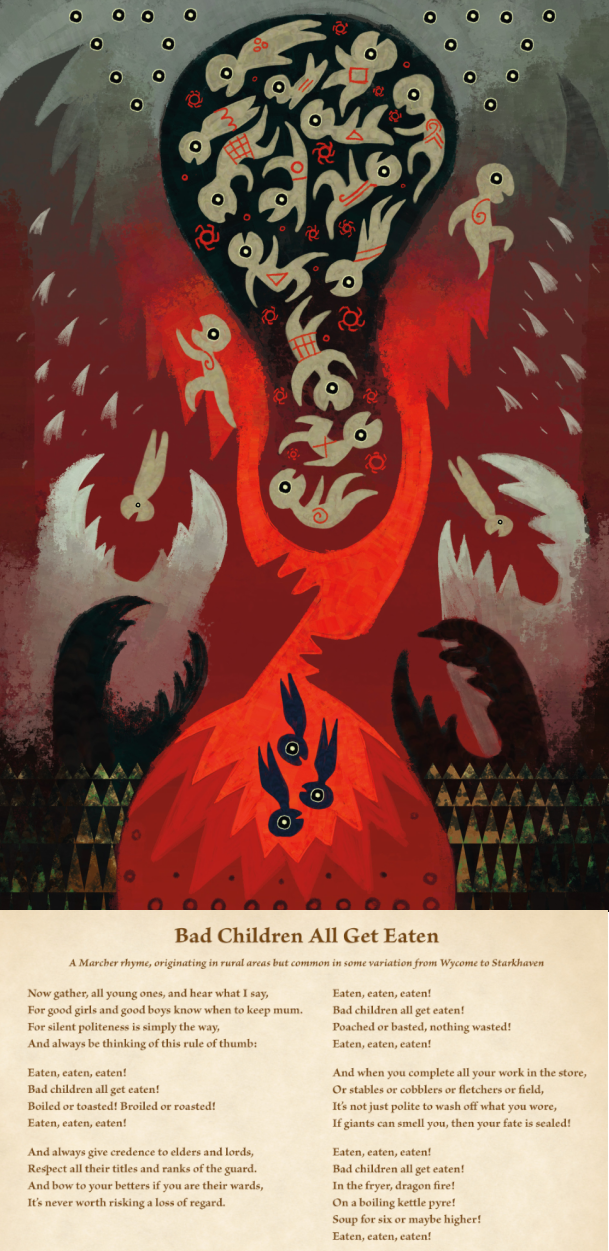
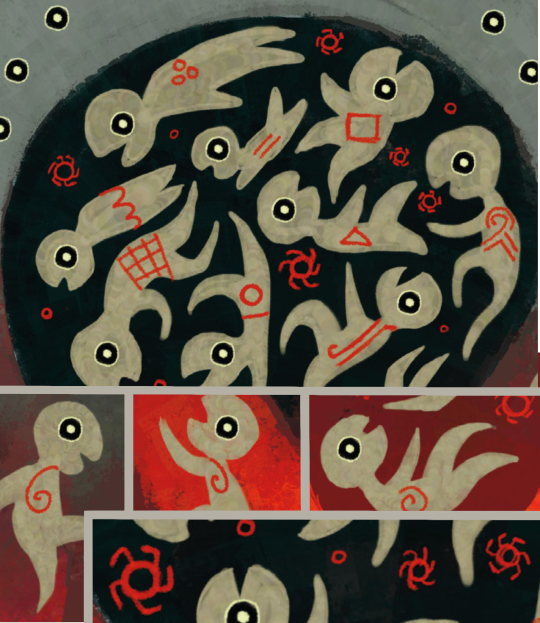
Another place where I found a sun-like symbol was in a very disturbing image of the book World of Thedas associated with a cautionary tale told to Free Marches kids. In it, we see that people/children are punished if they go outside a bubble of darkness with small “sun-like” symbols floating around. Each of these kids have a symbol on their belly or head. Curiously, one of these symbols is a small spiral that I’ve brought the attention upon long ago in the post Hinterlands: Statues, paintings, and structures found in the open where we found the alamarri statue I called Eroded dragon skull which has a “G symbol” on its back, which, at the same time, seems similar to the one present in a reiterative way all over the elvhen artefacts and in some dwarven rug designs.
I don't know how to interpret this image, mostly like the big black bubble that contains these klids seems to protect or shield them from the dangers outside. The kids that "behave badly" are dropped outside of it and are consumed by the dragon fire/jaws of the dangers outside. So in a very stretched way, we can interpret this image that the bubble filled with Suns protects people, or at least, it's the right path to follow not to be eaten by those monsters outside.
Conclusions
To put an end to this post, I would like to bring a short conclusion that we may have reached together along it. The Sun in Thedas is an ancient symbol that mostly every culture took to exploit and use in their own representation of gods/power.
This fact alone is not strange, since in anthropology we can see that severals cultures on Earth have developed religious rites or created Gods out of the Sun itself. The Sun is a symbol related to warmth, light, food, life, and security, so it seems reasonable for DA Lore to take it as the main symbol of Thedas civilisations.
The Sun in current Thedas is immediately associated with the Chantry and Andraste: it is a symbol of hope, of dawn, that provide the idea of new beginnings; it’s also the idea of the Maker itself and the Faith people have in him. It's also the fire that purifies in order to grant ascension [Andraste's case].
When it comes to Elvhenan, the Sun is immediately related to Elgar’nan, who was considered, according to the underaliable Dalish legends, the son of the Sun itself, who in order to save the Land shoved the sun into the ground, potentially causing a great damage to Dwarves and Titans.
There is also a symbol of a half-sun in an Eluvian, a statue, and in a hat worn by an elf, that may suggest that an original god, represented by the sun [potentially an ancient Dragon] was worshipped by the Evanuris. Lately, that symbol may have been co-opted by one of the Evanuris when they took divinity and the identity of the ancient gods they worshiped.
Elvhenan also seem to take the symbol of the asterisk as an oversimplification of the Sun, which across the murals, is also related to the heart of Titans, to power, and to the Golden Ring, which is also associated with control. So, for Elvhenan, we may suggest that the Sun represents immense power, if not, Divinity itself, that may end up being related to the core of Titans. The asterisk is also associated to the orb, a big power object.
Since Elvhenan were the first civilisation we know that started in Thedas [besides the Titans and their children], their symbols of power [asterisk, orb, golden ring] may have evolved along time to reach human groups which developed, later, all the sun symbols that ended up in the Chantry’s.
Thanks to Tevinter, we also can suspect that the Sun may have been a representation of an Old God, since they have a lot of sun-related images in their decoration and objects that belong to ancient times in which they were not Andrastian yet [in fact, so ancient times that Andraste herself was not born yet]. This may mean that the Sun symbol cloud have been taken from the Elvhenan or from the Ancient Dragons. Through Tevinter style, we also realise that the Elvhenan Golden Ring may have been used to create Breaches, which again shows and seems consistent with the idea of relating it to power and control. The symbol of Sun in Tevinter culture may be related originally with Elvhenan or with Ancient Dragons that Tevinter used to worship.
Dwarves have little representation of the sun for obvious reasons, but due to the unreliable legend of Elgar’nan and the war with the Titans, we may establish a relationship in which the dwarves endured the Sun [or the Elvhenan power] at some point in their story.
Thanks to the Grey Warden we can relate a sun with the idea of ancient Blood magic or ancient Dragon blood knowledge, since the Joining is represented by a chalice with a Sun on it.
The Avvar also have a low-key representation of the Sun in their Lady of the Sky, which may be just consequence of their deep relationship with the Elvhenan culture.
Par Vollen may have more answers about the Sun and ancient times, but the lore of DA world is very scarce on this region of the map of Thedas, so we can only speculate.
#Analysis and speculation of Statues#golden ring#alamarri#avvar#Chantry#Dragons#Elvhenan#Flemeth#Grey Warden#High Speculation#Old Gods#Tevinter#Par Vollen#sunburst#Sun-head creature#evanuris#Elven Ancient Shard-based door#yellow mosaic#mythal#flemeth#Elven Owl statue#Stone in Razikale-Ceremony-style#Sylaise#Elgar'nan#Asterisk Symbol#Free Marches Sun#Dwarven stone-paintings#lady of the sky
30 notes
·
View notes
Text
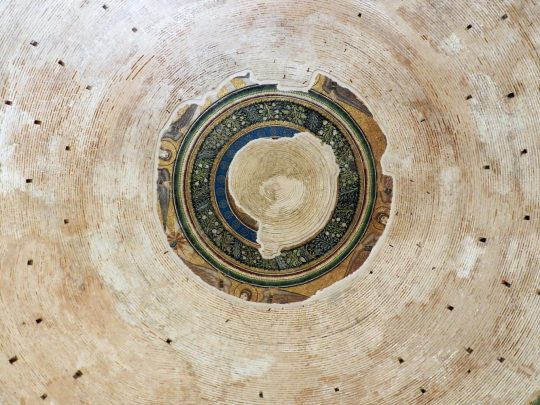

the rotunda mosaics: central dome, Thessaloniki. The Rotunda was built in 306, the mosaics added in the 5th century. The middle band of the mosaic is almost entirely lost to time. photo by Helen Miles Mosaics
2nd picture: tree rings via drought.gov.
#not trying to say anything here! just thinking about time. the places where the mosaics are missing#look so much like the rings of a tree#zoom in -- you'll see.#tree rings
21 notes
·
View notes
Text
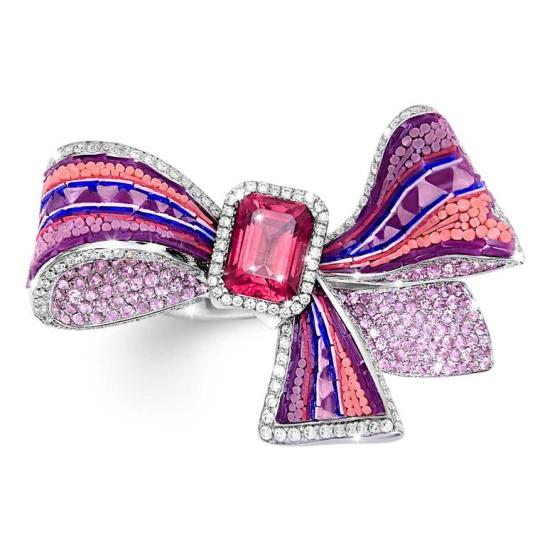
Pink Ribbon Ring by Sici's Jewels
Micro Mosaic, Rubellite and Diamonds
Source: thejewelleryeditor.com
#sici's#sici's jewels#micro mosaic#rubellite#diamonds#bow jewelry#bow ring#multi gem high jewelry#multi gem ring#micro mosaic jewelry#high jewelry#luxury jewelry#fine jewelry#fine jewellery pieces#gemville
144 notes
·
View notes
Photo

theodor-heuss-ring // köln kunibertsviertel
architects: paul doetsch & johann herbert klaucke
completion: 1936
and once again the theodor-heuss-ring.
for me, the street of representative post-war modernism in neustadt-nord.
what i particularly like here is that the buildings, with the park in the middle of the ring, have a completely different effect than similar ensembles in the densely built-up inner city. not to mention the special quality of stay for the residents.
#cologne#kunibertsviertel#köln kunibertsviertel#köln#theodor heuss ring köln#design#mosaic#rhineland#nrw#nachkriegsmoderne#nachkriegsmoderne köln#nachkriegsmoderne nrw#nachkriegsmoderne deutschland#nachkriegsmoderne rheinland#nachkriegsarchitektur#nachkriegsarchitektur köln#nachkriegsarchitektur rheinland#nachkriegsarchitektur nrw#nachkriegsarchitektur deutschland#post war modern#german post war modern#german post war architecture#post war architecture#cologne post war architecture#rhineland post war architecture#rhineland post war modern
32 notes
·
View notes
Photo

The Postman Always Rings Twice
directed by Tay Garnett, 1946
3 notes
·
View notes
Text



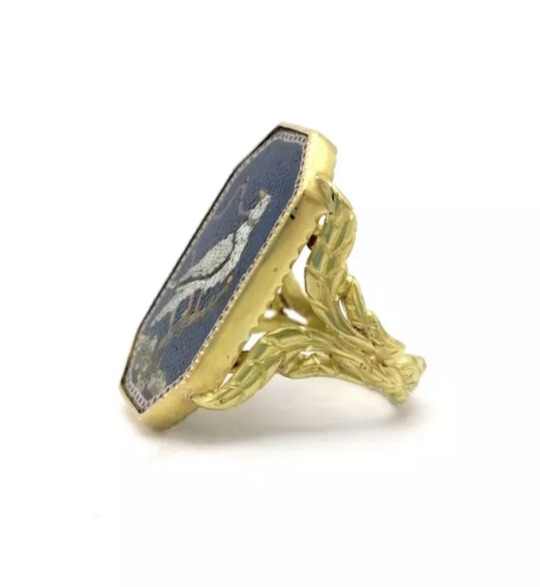

2022-8-10 $4,900
(3390) Gold Ring with 18th century Micro Mosaic of a Dove, Roma, Micromosaic
16 notes
·
View notes
Note
say i want to start green lantern comics - where would i start? is there a timeline? where can you read all the lantern corps lore?
So generally you'd want to pick a lantern and go from there! Here's a reading guide for most of the main lanterns! For Hal specifically I would read Emerald Dawn parts 1 and 2 first, and then read his 70s run starting with Hard Traveling Heroes to get the best idea of his character.
As for lore, that's where it gets tricky lol! There's a lot of lantern corps lore added with rebirth, so everything that has to do with other corps, is going to be found there. Green Lantern (1960) Annuals, and GL corps Quarterly are collections of oneshots that focus on random corps members, but I'd recommend reading some of the mainline run first just to get a gist of the worldbuilding. There's also Tales of the GL corps which gives a good rundown of basic GL lore!
#asks <3#ty for the ask!!#comic talk#honestly the wikia is probably a better and more coherent source of GL lore than the comics bc dc writers do not read comics ever#one day.... one day i will actually write out a reading guide......#the timeline would be like: gl corps is created. shit happens. central battery is destroyed. central battery is rebuilt. sinestro gets#chucked into the battery. battery blows up again. guardians ditch oa and leave appa ali apsa in charge. rings are dead.#gls build a hype house on earth. katma. mosaic happens. guardians come back. gl corps is rebuilt. coast city is vaporized.#hal has his girlboss breakdown and murders the corps killing all but one of the guardians and destroying the central battery. kyle is gl#there's definitely an actual timeline kicking around somewhere but i do not have one on hand </3#shoutout to the one quarterly issue where hal just recaps everything that he's done recently in chronological order. horribly dry#storytelling choice but great for me to figure out when shit happens
12 notes
·
View notes
Text

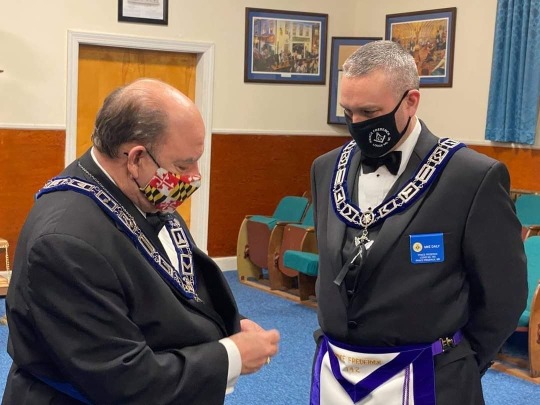

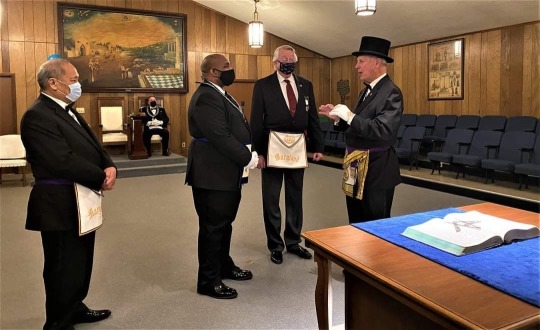
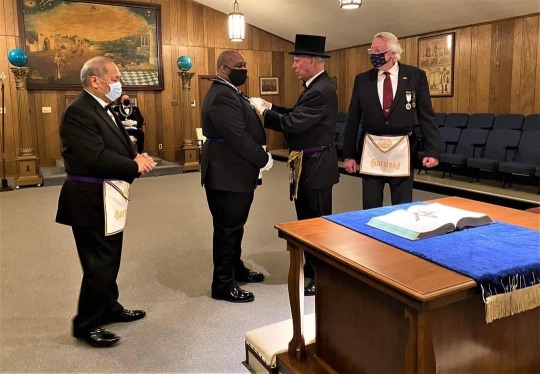
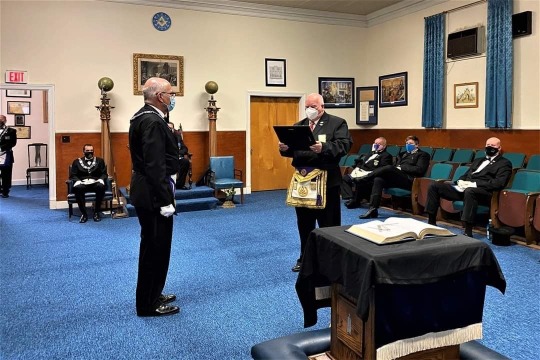




Masonry has the authorized power to print wealth wealth
Come and make your world a better place on earth join the FREEMASONRY now and accomplish your mission to see riches, power, prosperity, protection, fame, promotion, knowledge, wisdom,
Come to the FREEMASONRY follow the light 💡💡
#1950s#pauline hanson#pedro pascal#percy jackson#plushies#pokemon#pokemon violet#politics#pompeii#pink#mason illuminati ring masonic compass ring sterling silver 925 aaa63silver mens best ring bestdealmasonilluminaticompassring pricesalemasoni#mob pyscho 100#movies#roman mosaic#homework help#girl help#the rings of power#jerome powell#steam powered giraffe#famedverification#fameshed#fame on fire#hot celebs#biological anthropology#black and white#black lives matter#blacklivesmatter
3 notes
·
View notes
Text
Shop the latest photo from AshleesLint on Etsy
"Double Wedding Rings" has been updated to include center-out instructions! Contact me with your order number for the updated files 💕 https://etsy.me/3OzTtcg
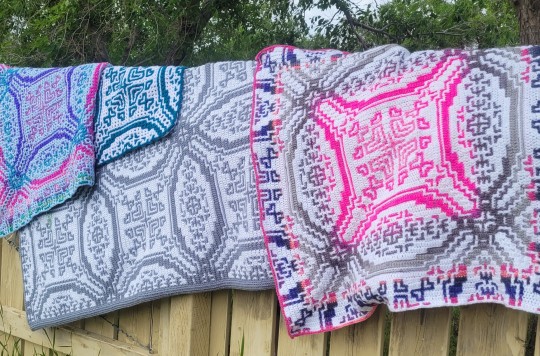
5 notes
·
View notes
Text
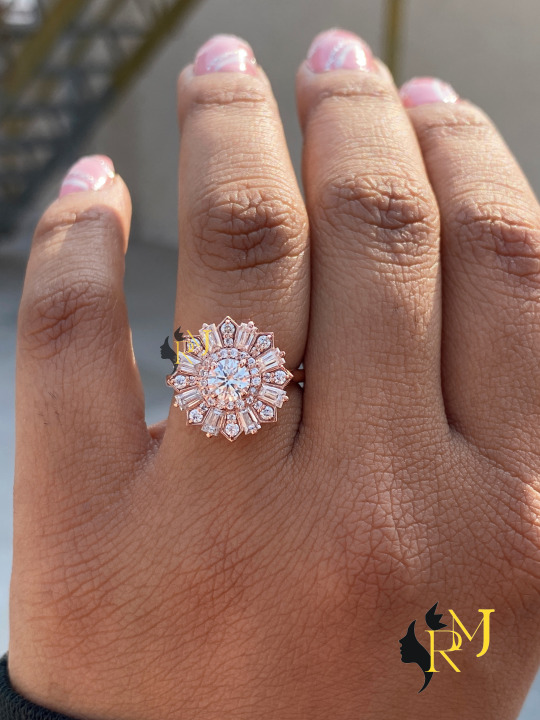
#Miss Radiant Jewels#Moissanite#Moissanite ring#engagement ring#diamond jewelry#diamond ring#jewellery#mosaic ring#round cluster ring#vintage rings#vintage fashion
0 notes
Text
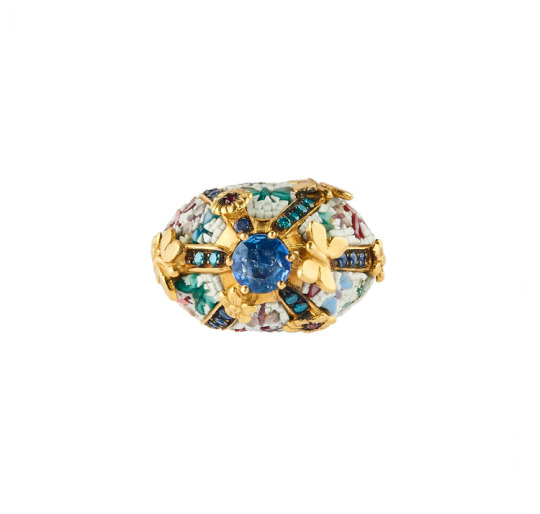
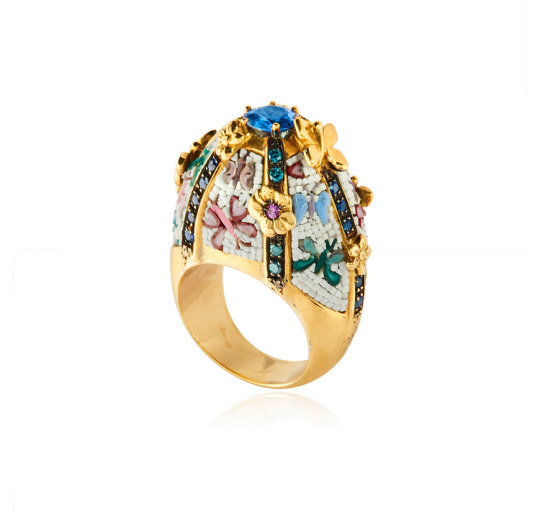
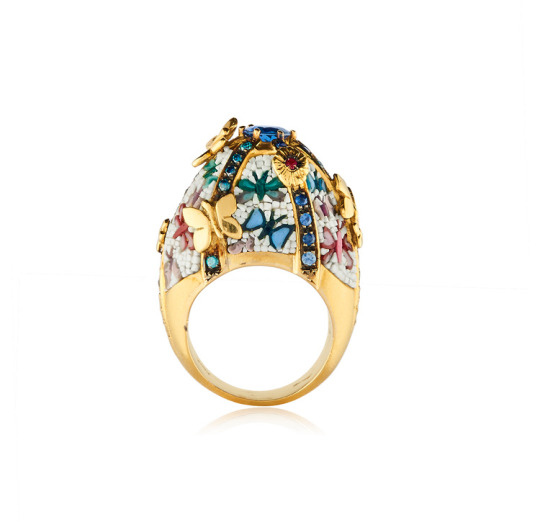
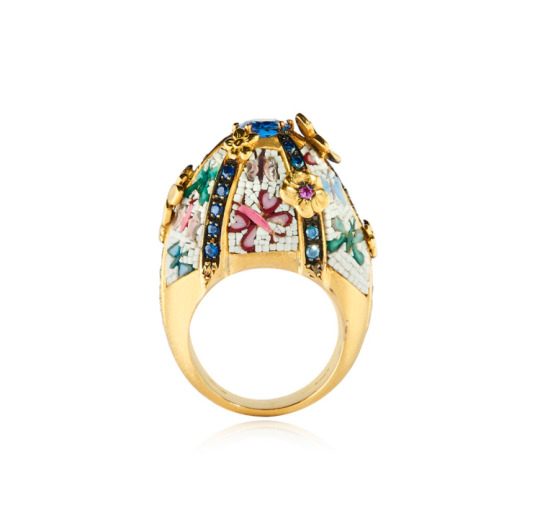
Butterfly Ring by Le Sibille
2 notes
·
View notes
Text
Ancient Elven codices; Fen’Harel’s mountain ruins
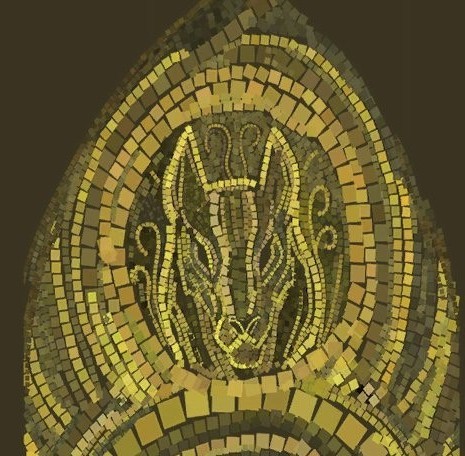
These mosaics are located in the Ancient elvhen mountain ruins, a place created by Fen’Harel to give shelter to slaves of the Evanuris and remove their vallaslin. His followers protected this place and taught others the truths about the Evanuris to fight them. Along the towers, there are mosaics focused on Fen’Harel, made of a material similar to Veilfire, which narrate a kind of positive “propaganda” of the Dread Wolf. As Solas says by the end of Tresspasser, they are not accurate, even though they are closer to the truth than the Dalish tales.
[Index page of Dragon Age Lore]
At the top of all the following set of mosaics appears Fen’Harel’s face, framed in a circle, with swirls behind him. We have learnt along the DA series that swirls can potentially mean “Fade” or “Fade magic” [as well as lyrium]. It seems fitting for him to represent Fade [especially if we take into consideration the Mural self-portrait, where we can see Solas as a wolf in the fade and as an elf in the waking world].

We also learnt, when people dug into the game files, that these same exact mosaics had alternative versions with different heads inside the top circle. Two of them resemble the Sun-head creature and Bull horn-head creature. The third one seems to be related to the heads of the statues found in the Brecilian Ruins in DAO, whether representing Falon’Din or Urthemiel. I personally think this shape is closer to the Archdemon Urthemiel than to Falon’Din [we see the prominent shape of three spikes].
This link to Urthemiel makes me be inclined to think that the other two heads belong to other Old Gods, but so far our exploration in Trespasser, it’s truly impossible to say what these symbols _really_ represent. We have a certain level of confirmation with the last trailer of DA:D, where we see these symbols representing the “guardians” [potentially the Old Gods for the Tevinters] of what’s hidden in the golden city. But before any analysis on this matter, there is a bigger question to answer: what are the Old Gods? The lore has been quite scarce about them. To be mere majestic animals such as high dragons seems to fall short. On the other hand, we know that Tevinter co-opted a lot of their arcane [and potentially religious] knowledge from the elvhes. Tevinters considered dragons as sacred creatures to create the idea of the Old Gods, but the elvhen had also previous, ancient divinities from which they wanted to emulate “its shape”. The elvhen codices only speak about a shape that allows flying, and due to the context surrounding the elvhen, it seems reasonable to think that they also worshipped dragons in ancient times when The Evanuris were not contemplating the possibility of becoming gods themselves. So, the link between two civilisations as worshippers of dragon-like entities is not so far reaching and I personally like it more than any comparison of the Old Gods with the Evanuris. After all, Dragon Age Franchise is the story of how the stories modify along the ages and through the civilisations that co-opt them. The “tale” of the Old Gods and what they truly are is still a mystery.
In any case, since these extra “heads” of the murals is material discarded from the game I will not waste time trying to understand it; we should be managing the already complex narrative of the lore of DA with what we were given, or clear Dev’s notes in order to keep using our principle of Occam’s razor. Material like this tends to mud the speculations.
Wolf Welcome

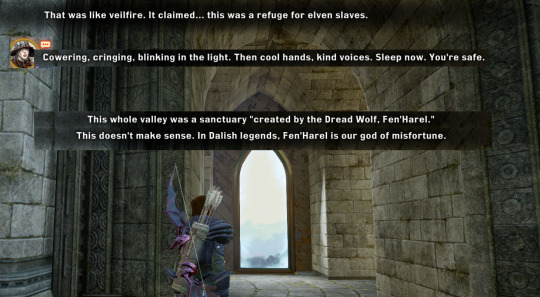
Wolf's Welcome, found at the Smoke Tower, which has an Elven Tree Statue on its top.
A wash of powerful magic carries an impression of welcome. Images flash by: elven slaves fleeing to this place in ancient times, greeted by others who then tend their wounds. Words are not so much heard as felt.
"Fen'Harel bids you welcome. Rest, knowing the Dread Wolf guards you and his people guard this valley. In this place, you are free. In trusting us, you will never be bound again."
Considerations of the codex and comments
Each mosaic of Fen’Harel carries a feeling. This one inspires welcoming.
The Dread Wolf appears once more as a protector, as it has been doing in all the ancient elvhen ruins, specially in those with Mythal.
The followers of Fen’Harel protect this valley [this reached to the point that they bounded themselves to these ruins as those purplish-spirits that Solas awoke seem to imply]
The word bound appears once more in an elvhen context, and we know what a heavy concept it implies in DA lore. This is the important detail in the text, in my opinion. In this mosaic we are hinted that the slavery of the elvhen may be related to a bound process.
The comment of the Inquisitor adds a little bit more of information:
These mosaics are made with something similar to veilfire.
This place was a refugee for elven slaves, made by Fen’Harel and his followers, so these symbols present in the towers [the Elven Tree Statue, Elven Archers, and Elven Owl statue should be related to him or The People, and not to the Evanuris [these statues annoys me the most].
Cole confirms that this place was a shelter for resting and recovering.
The design of the Mosaic
The mosaic shows a central object that can be interpreted as different things:
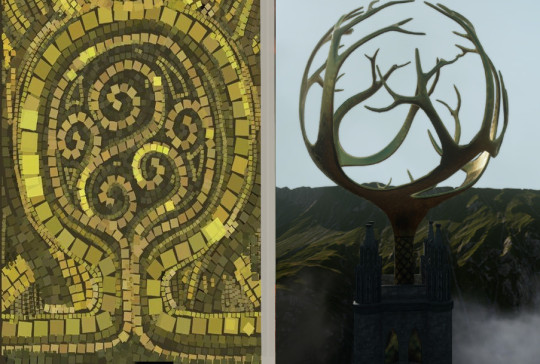
First, an spherical Elven Tree Statue. However the bottom of the tree seems to be connected or being one with the ground. This detail makes me suspect two potential interpretations:
One is about a pocket in the Fade, a “bubble” created from the Fade [as Raising the Sonallium shows]. DA franchise accustomed us to understand the swirls as representations of Fade magic, Lyrium, or Magic in general. These elven trees seem to represent the “source of power” that comes from Magic, that in contrast with the swirls of the mosaic, one could suspect it means “it was created by using the Fade magic” [like we see they create these spaces in the previous codex]. The way that this “bubble” is not completely disconnected from the “ground”, makes it look like a small pocket in a bigger membrane, so the nature of this place is similar to the Crossroads’. Morrigan told us that the Crossroads gave her refuge. During that time, Flemeth could not detect her, so it seems quite straightforward to interpret this mosaic as a visual representation of the nature of these “elven mountain ruins”. Here, the slaves would be isolated from the Fade, unable to be found by the Evanuris, while they recover.
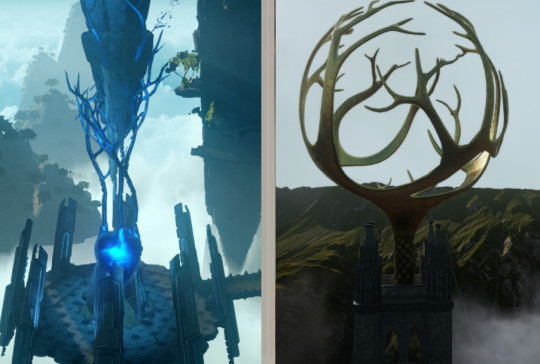
My second interpretation is not too different from the previous one, but the source of power of this pocket can be interpreted differently: the fact that the tree is connected to the ground, and the Elven Tree’s branches always looked to me like ramifications of lyrium vein, it changes the interpretation to a heart of a Titan or a Titan Guardian. It makes not much sense for Titans to give shelter to slave elvhen, but it could be an interpretation meaning that these pockets in between the waking world and the Fade are created by or use the power of the Titans [which are always related to creation and reinforcement of the reality, shape, and form]. In fact, both previous interpretation can exist at the same time, since powerful magic can be done via lyrium too, so the creation of these pocket space can potentially be done with magic enhanced with lyrium.
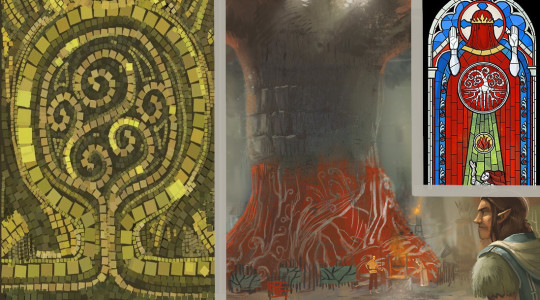
On a side note, I cannot help but relate the symbol of the swirls inside this pocket/tree with the symbol we find in the stained glass of the Chantry, in the Maker’s heart. The fact that in the stained glass we have a tree made of these swirls, in similar fashion to this mosaic, does not escape me. We know the Maker and Solas’ actions are strangely similar. It doesn’t seem too off for me to think that some elvhen survivor of this time spread the legend of Solas, and at some point, humans turned Solas, the elvhen rebel god, into the Maker, an entity that suited more the needs of the disconnected human groups spread all over Thedas. We know with the series of codices of “Before Andrastianism: The Forgotten Faiths, by Sister Rondwyn of Tantervale” that humans have been developing a lot of strange sects before the Chantry established itself as a strong institution. It seemed vital to unify the human religions in order to have some resemblance of peace and control over them.
Taking into account these similarities between the Maker and Solas’ actions, I support the idea that the Myth and the Folklore that gave origin to the Maker as a religion may have been inspired by Solas himself. It may have been done by an elf, who saw the actions of Solas [or was taught to into them]. We know that once Solas created the Veil, he disappeared, since he went to slumber. Fen’Harel followers may have wanted to keep his legend alive, as the Fall of Arlathan and the invasions of Tevinter put a full stop in the elvhenan empire. As the remaining elves escaped the slavery of Tevinter, the legend may have reached human ears who turned it into a tool to unify the so fragmented Thedas with the creation of the Maker, in combination, later, with the presence of Andraste. This is how, after all, most religions in real life history are made of: pieces of previous ones, modified to suit the needs of a certain population.
We know that those who created these mosaics were followers of Solas even though Solas rejected divinity, so they portrait Solas more perfect than he truly was in the past.

Curiously, this symbol in the mosaic tree seems to have been re-interpreted by the city elves and their Vhenadahl, which is decorated with white swirls in a red background. It seems to be inspired in this concept of the swirly tree of Fen’Harel mosaic as well as in the stained glass of the Chantry. Which makes a lot of sense since as city elves, they are the synthesis of the cultural aspects of the humans and the elves/dalish. So, in conclusion, I’m inclined to think that the trees keep representing source of power that may come from [Fade]Magic and/or Lyrium.
The Promise of Fen'Harel

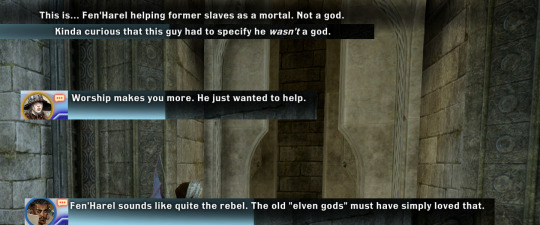
The Promise of Fen'Harel, found at the Silent tower, which is the one that has several Elven Archers around
A wash of powerful magic carries a pang of hope. Images flash by: a man in wolfskin standing with a group of freed slaves, clasping one's arm in friendship. Words aren't so much heard as felt:
"Fen'Harel has been falsely named a god, but is as mortal as any of you. He takes no divine mantle and asks that none be bestowed upon him. He leads only those who would help willingly. Let none be beholden but by choice."
Considerations of the codex and comments
This mosaic carries the feeling of hope.
It basically reinforces the idea that Fen’Harel is not a god, and was falsely turned into an Evanuris
Beside no taking divine mantle [I suppose this is the reason why Fen’Harel is a wolf instead of a dragon, he didn’t take “divine shape”] Fen’Harel only encouraged the willingly to join the rebellion [which we can suspect it may have had some frictions].
I think in this aspect we can see the grain of non-truth of this propaganda: those who read The Masked Empire know that Solas is capable of killing and removing the elements [Felassan] that will endanger what he considers the just cause. We don’t know how Felassan ended up as an agent of Fen’Harel, but clearly his perception that the city elves were “People” and should have a chance in leading the change, costed him his life. Fen’Harel did not accept such a deviant concept even though it also implied rebellion. Fen’Harel do not accept rebellion that will endanger the cause in his inner circle [which makes sense, otherwise, his organisation would have ended as a purposeless entity of chaos, like Red Jenny’s].
With Sera, he will have banter that reinforces the idea that any organisation is victim of corruption and needs constant cleaning. So the implied free will line in the mosaic may be an understatement.
Solas: Once you have the aristocracy weakened, Sera, you will have to redirect your lieutenants.
Sera: Oh, this again. All right, what am I doing?
Solas: Some of your forces, valuable until now, have no interests beyond creating disruption. Chaos for its own sake. They must be repositioned where they can do no harm, or removed if necessary. You replace them with organizers willing to build a new system and carry out the ugly work that must be done.
Sera: What? Why? What ugly work?
Solas: That is up to you. Do you wish to disrupt the nobility, secure a title? Or change the political structure entirely?
Sera: None of it! I don't want any of that!
The design of the Mosaic
The mosaic shows a circle with Fen’Harel in the center, and several elves around him, yielding spears. Five spears and four elves, which implies that the Dread Wolf “fights by your side as well”. The circle on the top with Fen’Harel’s face is connected with the other circle bellow, through an undulating pattern. Inside this undulation, at the bottom of the mosaic, we see veins and swirls, that we have always seen them as representations of the Blight, or Lyrium veins. Since these have no thorns [and the context makes no sense for a representation of the Blight], we assume they represent lyrium and/or Fade magic. The veins are inside the line that contains this Pocket, but there are also some swirls outside.
The inquisitor’s comment adds nothing to what we read in the codex. Cole explains to us that the true motivation of Solas for all of this was truly to help. Dorian reinforces to the player what we can infer so far: Fen’Harel was a rebel against the Evanuris.
The Lies of the Evanuris


The Lies of the Evanuris, found inside the Silent tower [with archer statues around], is placed in a very dark corridor that depict the “zombie” elves and the armoured figure which have been analysed time ago in Nation Art: Elvhen.

The mosaic gives access to a room that has a replica of the forgotten sanctuary and the three towers.
A wash of powerful magic carries a sensation of bitter fury. Images flash by: elven mages enslaving tens of thousands, making arrogant proclamations of godhood. Words are not so much heard as felt:
"The gods, our Evanuris, claim divinity, yet they are naught but mortals powerful in magic who can die as you can. In this place, we teach those who join us to unravel their lies."
Considerations of the codex and comments
This mosaic carries a feeling of bitter fury.
There is not much to say about this text. It shows that through slavery, the Evanuris could proclaim a fake godhood. It’s not clear at all if the process was similar as it is in DnD: the more followers/slaves you have, the more powerful a god becomes. We know, however, that Falon’Din went to extremes to starts wars in order to increase his worshippers, so quantity seems important. He also filled pools as big as oceans with the blood of his defiants [Solas’ words, Temple of Myhtal]. So maybe there is power in the quantity, or in the amount of blood you spill .
The Fen’Harel propaganda reinforces the concept that the Evanuris are mortals. Which is a bit confusing to me; we have been told that elves were immortal during the time when the Fade and the Waking World were one [Solas’ words at the end of Trespasser]. Solas also tells us that the Evanuris are not easily killed. We conclude with Jaws of Hakkon that this must be because spirit-like entities reborn when they die, even though they may change in the process. So claiming here that they are mortal mages… feels strange. Maybe here is the half-truth of this propaganda? The Evanuris are not gods, but they still have their ancient elvhen spirit-like nature? Or maybe I’m just being too picky with the wording and they are saying “mortals” as an antonymous of “god-like”.
Still, it seems very strange to read the word “mortal” in a pre-Veil world. Then again, as the companions and the Inquisitor speak later, maybe it’s just a tale to rebuild the confidence of the slaves and get rid of the old propaganda.
The design of the Mosaic
This mosaic is one of the most curious one of the series in my opinion, and not by chance placed in a room we can barely see due to its darkness. This has to be a mosaic with interesting lore. First, let’s analyse what we see, and then how we can interpret it.
What we see:
It shows a creature with horns and pointy ears, chained around their waist. At the sides of the creature, there are two central branches of what looks like lyrium veins [they end in a swirl, making it look even more related to lyrium veins]. They also may look like columns. There are three drops of a blue liquid that fall from the captured creature. These drops are the only element in the mosaic made of an intense blue colour, making it an indicator, almost undeniable, that it is lyrium. Between the “horns” I see a dark circle that may or may not be relevant. The horns could potentially have an interpretation of “two spheres overlapping, one central dark one, another golden in the background.” This golden sphere comes from the head of the elf.

Regarding the branches, they are drawn in a different direction that we usually see them in the DA art: which is from the bottom spreading upwards. They appear at the bottom of mountains [or mountain-like visual], to emphasise the concept of lyrium vein [this can be seen a lot in the presentations of DAO, DAO Awakening and DA2 act presentations: Act 1, Act 2, Act 3 ]. In DAO we see more the association of the swirls with the Lyrium. In Awakening, we see veins raising from the bottom of mountains. In DA2, the veins grow from bellow [mountains or buildings] in concept art and in-game murals [like the one representing Flemeth], and in the DLC the Mark of the Assassin, we see only one vein in a different direction of what we usually see in the mountains.
It has several potential interpretations:
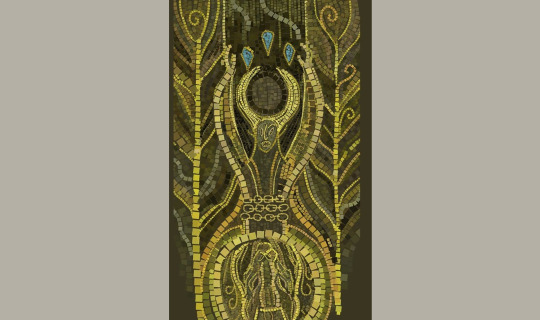
First interpretation: Since the direction of the branches is unusual, maybe the creature is not hanging upside down, but they are sinking into the circle that displays Fen’Harel’s face. The top of the image would be the “bottom” from where the lyrium branches grow. The body of the creature seems to be one with this circle [some lines that seem to draw the robe of the creature are fused into the circle, bringing the idea of The Horror of Hormak, where we learnt that slaves were sent to the bottoms of the mountains to be submerged into pools of a strange liquid altered with lyrium crystals, in order to produce chimeras or monstrous merges of souls. The book provides enough evidence to be quite sure that this was Evanuris’ doing, and if we combine it with the information of the codices Ancient Elven codices; Vir Dirthara and the codex of the mural of the titan: Veilfire Runes in the Deep Roads, we know that the Evanuris did something terrible underground that required them to collapse part of the Deep Roads to hide it.
Cons of this interpretation:
It makes no sense that the “bottom of the mountain” leads to Fen’Harel’s circle.
The book of Tevinter Nights says that over the piles of brine liquid there is a lyrium crystal, not three. Those three drops of lyrium could be seen upside-down, as diamond-shape crystals, but in any case, it makes no sense that there are three of them when it’s only required one according to this book.
If the horror happening in Hormak is what truly made Solas banish the Evanuris, we also know by the Dev’s note we find in the Unknown Ruin [read “The Crossroads [DLC Trespasser]: Deep Roads; Unknown Ruin”], that he had decided not to share what the Evanuris did to avoid future temptation from anyone else. So it seems unlikely for him to share it with his followers so they can put this secret in a big mosaic, lol.
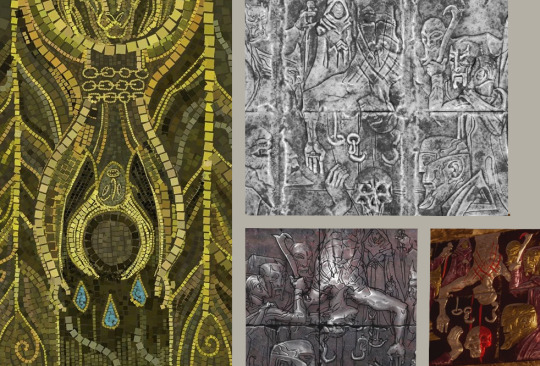
Second interpretation: The creature hanging in this mosaic has horns. They may be interpreted as a qunari. If we see the Tevinter Mosaics, in particular “sacrifice”, we will find out that this situation looks pretty similar to the central figure in the Tevinter mosaic who is hanging upside-down. We learnt that this figure used to have horns. Gatsi says it may have been a Qunari. But the time of the elvhenan is quite more ancient than the time of Tevinter, so this creature hanging in the Fen’Harel mosaic could have been a Kossith for all what we know. Or anything else. Exactly because we keep in mind The Horror of Hormak, this creature could have been any creature made by the elvhen using those strange merging-pools: it could have been a Qunari, a Kossith, or even a proto-darkspawn chimera.
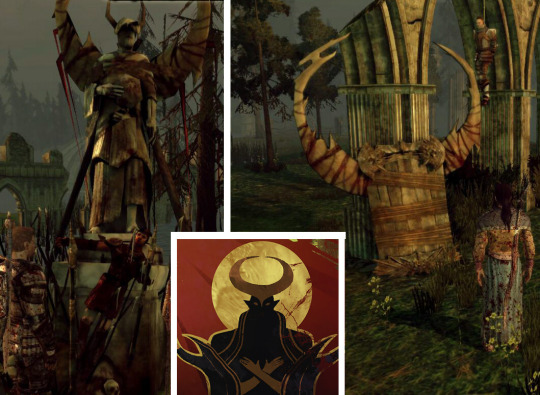
The darkspwan have been venerating a figure with beetle horns since DAO, so maybe there is a link there.

We also know that there is a link of this symbol with The Architect [those weapons can be bought through the nexus golem]
One could argue that makes no sense for a proto-darkspawn to be here, but I think it’s worth considering because the dwarves [specially the shapers], unlike the surface humanoids, do not attribute the origin of darkspawn to the Sin of the Magister Sidereal [Darkspawn], but to an underground cause, potentially an original broodmother living deep into the Stone [ The Eternal Battle: Darkspawn]. So, the origin of the darkspawn could be explained through these pools from The Horror of Hormak; where a creature, equivalent to an underground broodmother concept, was born. [This concept of a corrupted, underground creature as the origin of the darkspwan is not super reliable, but it seems to have some level of certainty since it’s supported by two shapers. Even if this information is a leftover of some alterations to the truth, the concept that the origin of the darkspawn comes from below and not from a violation of the Fade remains].
Regardless the race of the victim in the mosaic, we can interpret it that the Evanuris hang this creature upside-down and make it bleed lyrium. The Tevinter Mosaic tells us that Tevinter performed this ritual in their history: qunari were left to bleed in order to cast powerful magic. Since Tevinter has an old History of co-opting elvhen knowledge, I don’t find it too out of reach to consider that the Tevinter took this ritual from the elvhen past as the foundations of their own and adapted it to their own needs [as they always do] and started to use Qunari [in case the elvhen had nothing to do with the Qunari]. In the Tevinter version, the ritual seems to need the spill of blood, while in the elvhen version, it’s lyrium.
Cons of this interpretation:
The race of the victim is not clear at all and tarnishes more than confirms all the speculations we had developed up to this point. It releases the wild conspiracy-guy board attitude I want to avoid.
The lyrium drops makes no sense with any of the races I’ve listed.
Third interpretation: This mosaic may represent part of the Tale that Solas told us in the Temple of Mythal - Part 2: when Falon’Din went too far killing followers, Myhtal [and apparently Fen’Harel as well if this mosaic is correct] rallied the gods to stop Falon’Din and bloodied him in his temple. So this figure is Falon’Din, bleeding.
Cons of this interpretation:
This would relate Falon’Din to a figure with horns, which seems to be incoherent with all the iconography we have found about Falon’Din [the statues of DAO].
Even more incoherent is the fact that he is bleeding lyrium. Do we know if Evanuris bleed blood? no, that’s true as well. Flemeth doesn’t count since she is a possessed human. And even though Solas bleeds blood, it is never clear if he can be considered an Evanuris, since he “rejected the mantle of divinity”, and his massive power seems to come from an accumulative artefact [orb] and not from himself. This changes only when he absorbs Flemeth.
That tale and the text of the mosaic, in combination with its title make little sense. Falon’Din was bled in his Temple to stop him in his mass killing, not for lying.
He doesn’t have any element of Falon’Din’s mosaic to identify him as such.
Fourth interpretation: Following an interpretation more simplistic and using the Occam’s razor to the maximum: we focus on the fact that the creature bleeds lyrium and the horns may be, in fact, two spheres overlapping. In this way, we can interpret this creature as the only one who we know, lore-wise, bleeds lyrium: a titan. It would make sense to see the chains around its waist as a symbol of defeat, while the two branches at the sides could still be considered “veins of lyrium”, but also they can look like “columns of the earth” taking into account all the commentary I’ve already done about the direction of these veins. The titan is trapped in the depths of the mountain where the origin of the lyrium veins start.
This interpretation links this mosaic with the mural of the Titan’s Death and its codex: Veilfire Runes in the Deep Roads. We know the Evanuris mined the body of a defeated titan, and made “something else”. Whatever that “something else” entails, I don’t think Solas would reveal it to his followers, because that’s the determination we read in the Dev’s notes of the room where this mural has been painted:
Dev’s notes: “A final eluvian is situated in a peaceful bolt-hole where Solas has painted murals. Fen’Harel was here and wanted to make sure nobody ever found what the other gods were doing. This place was the breaking point for him that turned him against the gods.” [Source: Corseque]
He wants the “something else” to remain a secret so nobody is tempted to use such power. More details in “The Crossroads [DLC Trespasser]: Deep Roads; Unknown Ruin”.
So, in short, we see this mosaic called “The Lies of the Evanuris” which explicitly says that the Evanuris are gods because they are “powerful in magic” [this is the concept that should be a lie], and when we put it in contrast with its image, it seems to imply that such power comes form Lyrium [the blood of the titans]. So, a simplistic approach to interpret this mosaic is that we are seeing the representation of mining a Titan, which is what grants them great powers.
Now, titans are of colossal size, so it’s unlikely to have them chained upside-down, but this drawing may be a representation of the process of mining their bodies through a process that will leave them helpless. But what process does it?
We know through Cole as we explore the series of posts “The Crossroads [DLC Trespasser]: Deep Roads” that the titan seems to be sleeping, unable to awake [”Songs screaming far away. It wants to wake up but can't remember how. No one should be here”], and we can assume it may have been caused through some procedure that the elves did onto it. After all, we know via the Ancient Elven codices: Vir Dirthara, that titans were active before the war against the elves, and put in danger their fluid civilisation. For the elvhenan was vital to force the Titans to stay “quiet”. Probably when they discovered the power of the lyrium, they needed to keep the titans even quieter, to control the shake of the world, but also to proceed to mine them.

At the end of the exploration of the Deep Roads, we find dozens of coffins with elves in Uthenera [we know this because Cole says “They're all singing. Coffers, coffins, corpses that aren't dead. A song crying out in the dark”], suggesting [when we combine it with the other lines that Cole drops in the same place] that they may be the reason why the titan sleeps. I’ve have been toying for a long while in many posts with the idea that Uthenera was not what the Dalish say it is, but a more horrifying procedure with a different objective. The Deep Roads of Tresspasser seem to suggest so, as well as codices as A Flowering Imago, explained in Ancient Elven codices; Vir Dirthara.
Now, what annoys me of this interpretation is the visual of horns. However, the design of the mosaic suggest that these golden protuberances are not part of the head, as horns usually grow from the skull of the creature. This detail in combination with the suspicious, perfect dark circle inside, made me reconsider this image.

What if, instead of horns, it’s two overlapped circles, one bigger than the other. If the smallest one is not centred, it can allow the creation of a looking similar to horns. However, as it can be seen, it doesn’t look like the case. This idea is a bit useless.

Another similar possibility to consider: these murals and a lot of art in DA franchise is related to [gold] halos around heads or behind bodies. They tend to be a representation of godhood and sanctification. If we understand the “horns” as a golden sphere [or halo of supposed “divinity”] which is slowly covered by a dark sphere [orb, true source of power], one could come to see something similar to this [this is seen in the corridor behind the statue of Mythal in the Inverted Ward]:

The orb [which seems to be related to power according to Solas’ own words in Attack to Haven and in the end of Tresspasser, where he says the orb accumulated his power through millennia of slumber] and the Golden Ring [which seems to be related to mental control of the creatures according to Nation Art: Elvhen], inside a bigger golden ring, which could be the “golden halo” of divinity. Maybe all these elements can be related to the vegetative state of the titans in current times. [I hate this explanation, it’s so complicated, it should not be like this!]. This process may allow the creature to be drained of its precious liquid that gives god-like powers to the Evanuris without reacting at all.
Somehow, this interpretation gives room to the second interpretation in the sense that this knowledge could have been co-opt by Tevinter at some point in the History, and emulated it with different races [even maybe finding the need to create qunaris to reproduce the potency of this elvhen ritual]
Cons of this interpretation:
Still there is a lot of speculation. A Lot for my taste.
I’m not convinced at all about the explanation of the horns. This explanation is very far from any Occam’s razor. However, bleeding lyrium is a very strong argument to relate the central creature to a titan.
The chains around the waist of the creature may be a representation of being defeated, but it seems unlikely that a Titan has pointy ears. It’s true that we have no visual reference of them, but if they are similar to dwarves [I’m assuming the trope of gods creating their children similar in image to them, of course], makes little sense to present them with long pointy ears.
There is no room to make the events of The Horror of Hormak fit in this interpretation, if they are related. But on the other hand, we didn’t have this book when the DLC came out, so the most natural interpretation should come from the information already given in the game.
The fact that you need the presence of the orb to interpret this is questionable, specially when it is suggested in several murals and mosaics that the orbs are creations from the heart of titans. You may need to kill one titan first to create an orb and use it to control the mind of the rest. This hypothesis hides too much over-complication later.
Conclusion: I can’t have a strong, integral interpretation of this mosaic.
The Lifting of the Vallaslin
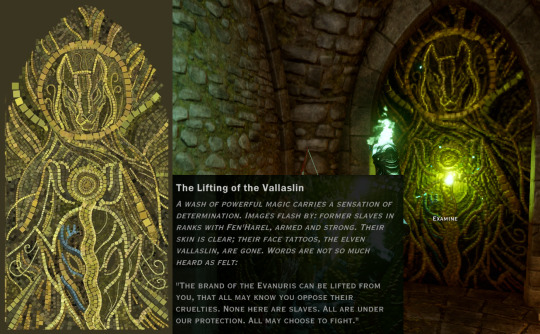

The Lifting of the Vallaslin, found at the Forgotten Sanctuary, right after the mural of the removal of the Vallaslin.
A wash of powerful magic carries an sensation of determination. Images flash by: former slaves in ranks with Fen'Harel, armed and strong. Their skin is clear; their face tattoos, the elven vallaslin, are gone. Words are not so much heard as felt.
"The brand of the Evanuris can be lifted from you, that all may know you oppose their cruelties. None here are slaves. All are under our protection. All may choose to fight."
The Inquisitor who romanced Solas adds at the fresco found before this mosaic: "That's Fen'Harel removing Dalish vallaslin? Solas said they were used to mark slaves."
Considerations of the codex and comments
The emotion it carries is determination.
The text says little extra information. The former slaves became rebels that fought by Fen’Harel’s side for their freedom.
These elves could remove their vallaslin, so they looked like cleaned skinned elves.
Here we are repeated once more that the vallaslin is a brand of the Evanuris.
The design of the Mosaic
In the mosaic we see that the figure of Fen’Harel has rudimentary arms and hands that hold an orb [as we can see, the design of it is different to the one we wanted to interpret in the previous mosaic]. This potentially means that these orbs contain the power to remove and apply the Lyrium Vallaslin through which the elves became slaves. From it, an undulating thick line divides the elf’s face below. We have a suspicion that the elven lines of this kind are associated with slavery.

We know that the aravel are ships where they sent their elvhen slaves to the horrifying mountains where they were victims of experimentation [The Horror of Hormak] and they are decorated with these lines. The lines in the mural of the removal of the vallaslin, as well as the water from where these elves come, seem to be represented with blue undulating lines [once more, the idea of lyrium is reinforced]. Submerged in that water there is a clear elven orb. In the mural of the creation of the Veil, we find two orbs: one golden, another blue. The blue one has the undulating lines downward, which is mostly how we see them in this mosaic. This blue representation of the orb may be interpreted as a tool related to lyrium, while the golden one, I’m more inclined to think as god-related in the Evanuris sense, containing the power to produce slaves [hence the lines].
Returning to the mosaic, the Vallaslin lines on the left side of the face are in blue, meaning they were done with Lyrium. The Evanuris branded their slaves in similar fashion that Fenris was marked. This makes us suspect that, once again, Tevinter had knowledge of these ancient elvhen practices and tried to make their own versions to fulfil their “necessities”.
I don’t know if I’m seeing too much, but the removal seems to cause changes in the physiognomy of the face: there is an important asymmetry between the two halves and it seems that the left angular shape was rounded once the vallaslin was removed, and the eyes increased its size. Even though the text doesn’t say anything about this, and due to the context of seeing Dalish elements in these ruins which are still present among the modern Dalish [like the snucksuit and the banners and flags], I’m tempted to infer that this removal of the lyrium Vallaslin caused a change in the elvhen shape, making them look more like the Dalish [brand-free elves] which physique is very distinguishable in comparison with the Elvhen’s, [through the lore of the Sha-brytol (melted faces) and Fenris (white hair), we know that infusing lyrium may produce physical changes, but these are supposed to appear _after_ the infusion, for this reason I’m a bit sceptical about this interpretation. Maybe I’m seeing too much.]
However, we know that in Masked Empire, while exploring an elvhen ruin, Briala remarks how big are the steps of a stair, and Felassan answers in his evasive style: maybe we were taller before, implying that elves truly changed physically. It’s not clear to me if it was because the Veil or because some effect of the vallaslin.
The staircase widened as they went down, until all four of them could comfortably walk abreast. The steps themselves were slightly longer than was normal. It took just a bit longer than a normal stride to cover a single stair, but not enough for two, and Celene found herself settling into an odd rhythm, taking two short steps and then a long. It made her think of the dances written in three-beat form, and she had to stop herself from humming.
“These steps are oddly sized,” Briala said ahead of her.
“Perhaps we were once taller,” Felassan said with a chuckle.
Is all of this true?
At the end of Trespasser, we have a long conversation with Solas and several details arise. When the inquisitor claims to know the truth about Fen’Harel due to these mosaics, Solas says:
“You saw another story, written in desperation to give me more credit than I ever deserved.” [video]
“They are closer than the Dalish legends, though still prone to making me into something more than I am.” [video]
Solas implies that the elven mountain ruins belongs to a time before the sealing of the Evanuris. These mosaics clearly depict Fen’Harel as a concept, as a creature which is the embodiment of Rebellion against the Evanuris, not a person. En these mosaics, Fen’Harel is shown in a better way than the unreliable Dalish tales do which make out of him a god of trickery.
The mosaics focus too much on the presence of Fen’Harel, and maybe this is the “Fen’Harel propaganda” that Solas refers to. After all, the mosaics are written in a way that suggest that those who worked with the recently escaped slaves, feed them, give them shelter, and taught them about the truths, were followers of Fen’Harel, not Solas himself. Solas may have created this space, but it was sustained and maintained by his followers who almost, ironically, worshipped Fen’Harel. In fact, during the exploration of these ruins, we see fighters who had bounded their spirits to the place to defend it, and invoke words and passwords related to Fen’Harel [and potentially to Anaris]. I found this a disturbing thing considering how averse Solas is to bounding spirits.
“I did not lead a rebellion against immortal mage-kings without getting my hands bloody”
“You were people, and you deserver better… like all the rest I have used in one hopeless battle after another”
“You created a powerful organization, and now it suffers the inevitable fate of such: betrayal and corruption”
“Briala controlled part of the Labyrinth. One of my agents was supposed to take it from her, but he did not succeed. I had to override the magic personally.” [video]
The main aspect that the mosaics show is that Fen’Harel is a fatherly figure that will give choice to fight against the Evanuris and will offer shelter no matter what. However, by Solas’ words, and his own actions through the book The Masked Empire, we know that this is an idealisation created in these mosaics. Solas could have never led the Rebellion without killing and using people. He seems to regret it, but the actions were taken, it was the “dirty work” that had to be done to free his people. He speaks of organizations suffering corruption and degradation, and with Sera, we know he speaks about “cleaning” the group when some member begins to shift away from the original purpose of the organization. We saw this action with Felassan, even though Solas regrets it [Cole says in this aspect: “His friend (Felassan) had to die. Because he thought they (city elves) were people. A slow arrow (Felassan) breaks in the sad wolf's jaws”.]
“I sought to set my people free from slavery to would be gods. I broke the chains of all who wished to join me. The false gods called me Fen’Harel, and when they finally went too far, I formed the Veil and banished them forever. Thus I freed the elven people and, in so doing, destroyed their world.” [video]
“Had I not created the Veil the Evanuris would have destroyed the entire world. [You did not kill them]. You met Mythal, did you not? The first of my people do not die so easily. The Evanuris are banished forever, paying the ultimate price for their misdeeds. [what did they do that made you move against them?] They killed Mythal (chuckle). A crime for which an eternity of torment is the only fitting punishment.” [video]
“[Mythal] was the best of [the Evanuris]. She cared for her people. She protected them. She was a voice of reason. And in their lust for power, they killed her.” [video]
The mosaics claim that everyone is free first and then can choose to fight against the Evanuris. Solas’ words imply this in the other way around: if you promise to fight against them you will be granted freedom. It may have been a security procedure in order to avoid the proliferation of free elves that may end up selling out the rebellion. I don’t know. My point here is that we can see in Solas’ words how “real” situations and events are rawer and cruder than what legends and tales explain [which is what we read in the mosaics]. This concept is continuously repeated along the DA series.
All these mosaics are from the time when the fight was against the Evanuris, but he seems to imply that when Mythal was killed [which is an event related to the Titan’s death, something he wanted to keep in secret according to Dev’s note] he stopped working with his rebel groups and took the most drastic option: the creation of the Veil. He did it because what the Evanuris had caused [which we can speculate could have been the Blight, the creation of the Red Lyrium, or something else that we had seen in The Horror of Hormak] would destroy the whole world. To protect the world, he ended up altering the nature of the elvhen forever.
#Evanuris Mosaics#evanuris#fen'harel#Sun-head creature#Bull horn head creature#solas#Titans#elven orb#vallaslin#Golden Ring#Vhenadahl#elven tree statue
62 notes
·
View notes
Photo

Contemporary Powder Room - Powder Room
Inspiration for a modern powder room renovation featuring gray walls, concrete countertops, and an integrated sink in a gray tile and stone tile floor.
1 note
·
View note
Text

This remarkable ring by Alessio Boschi features a perfect reproduction of the 4th century B.C. mosaic of a gorgon medusa from the Baths Of Diocletian covered with a 3.00 carat portrait-cut diamond
Source: thejewelleryeditor.com
#alessio boschi#micro mosaic#diamond#high jewelry ring#work of art#medusa#baths of diocletian#high jewelry#luxury jewelry#fine jewelry#fine jewellery pieces#gemville
216 notes
·
View notes